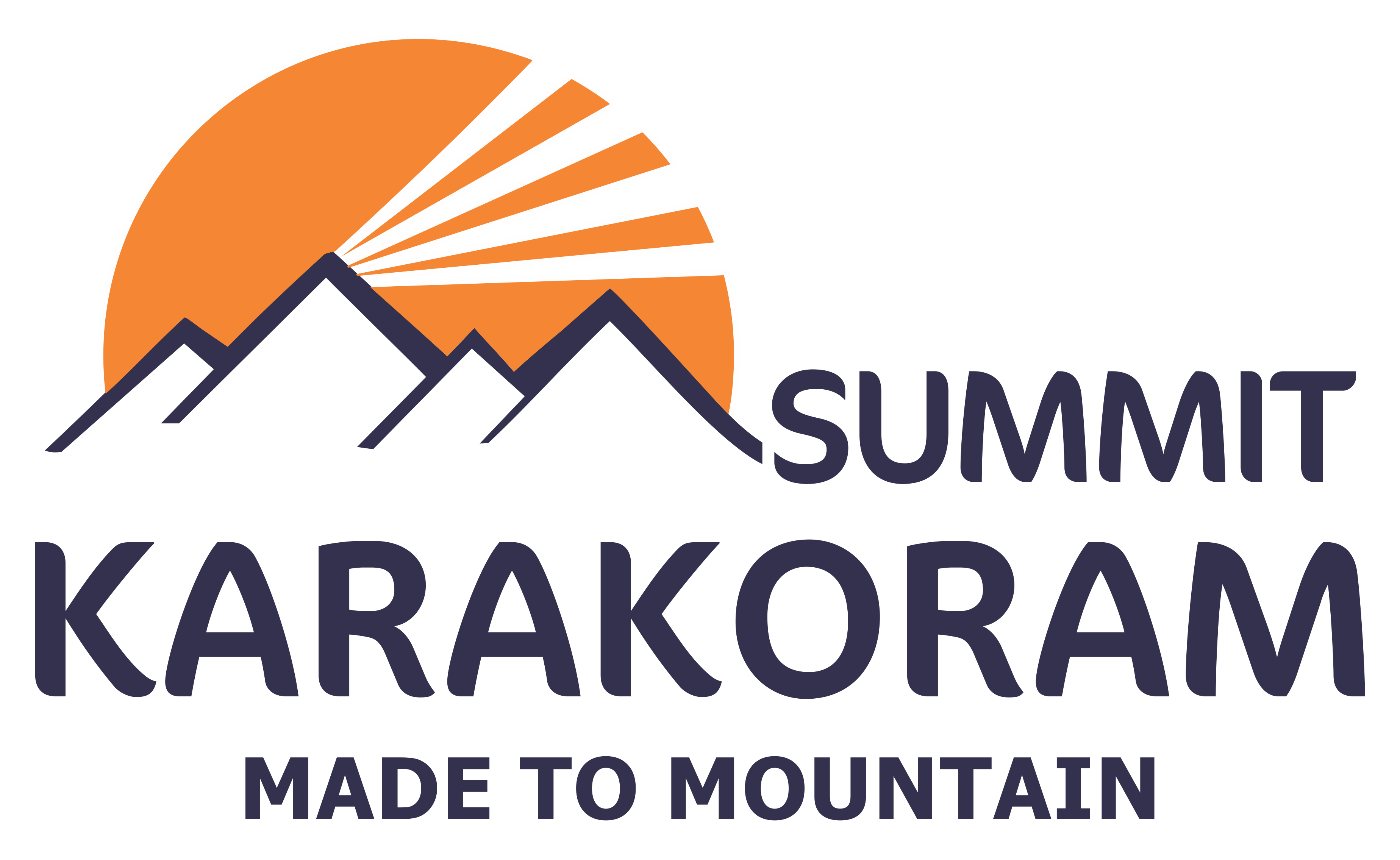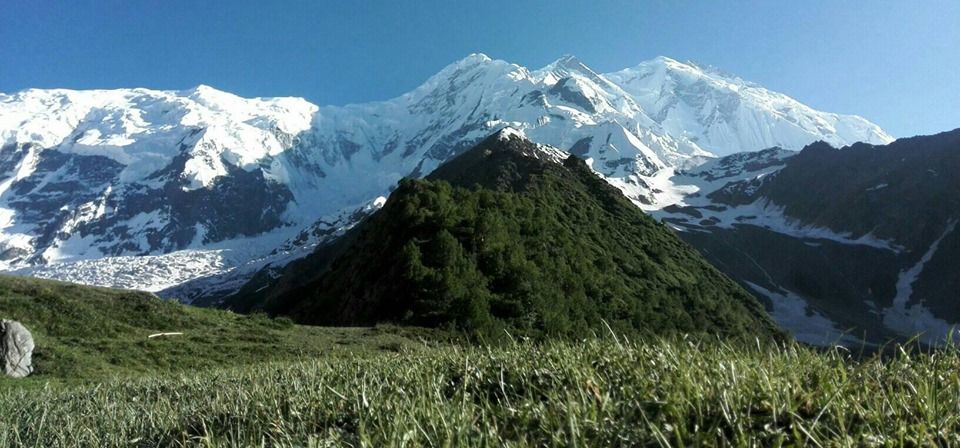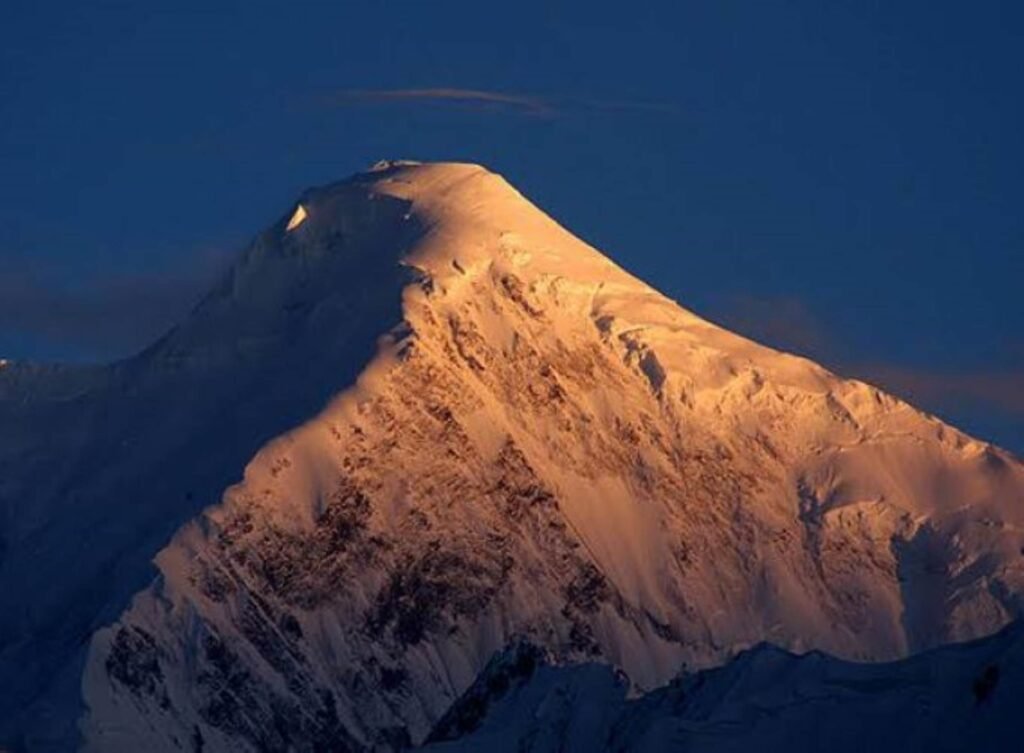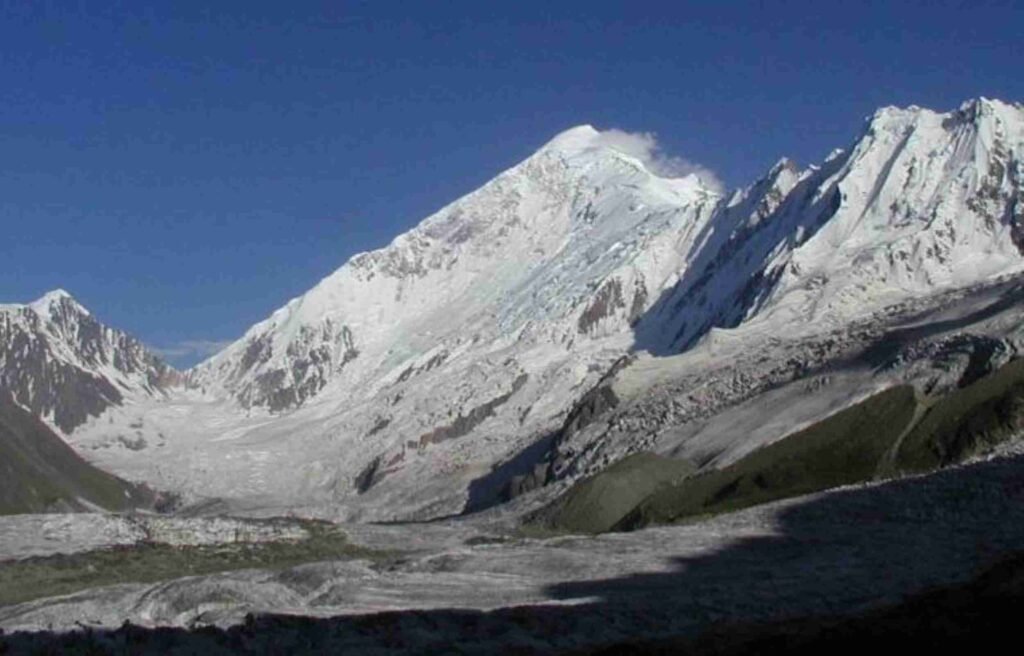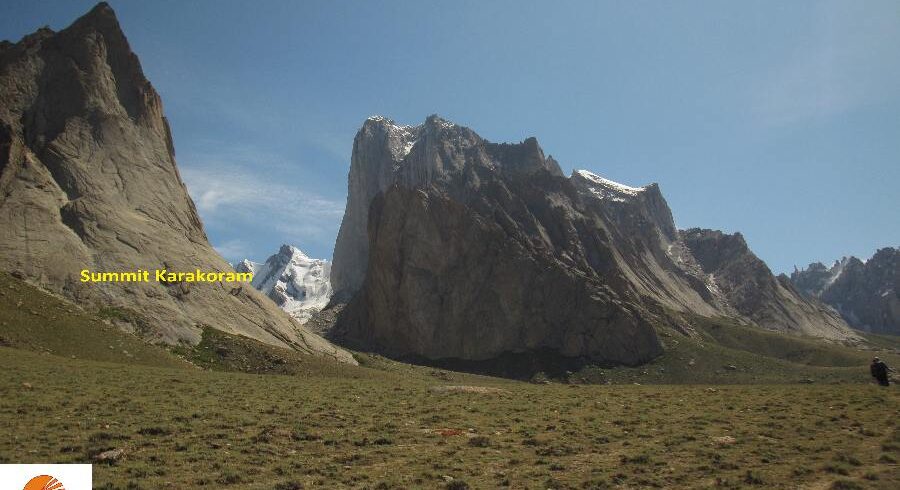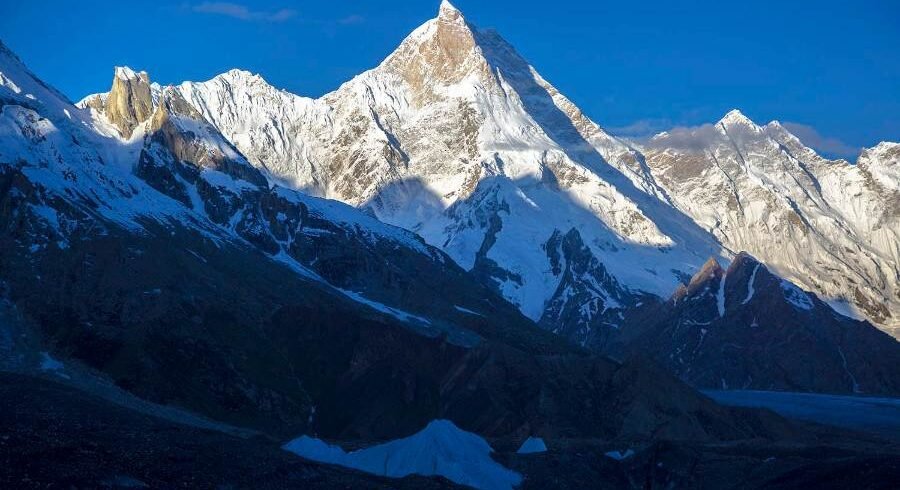Overview
Diran is located in the Rakaposhi-Haramosh Range in the western Karakoram. Viewed from the Hunza Valley, Diran is a gentle pyramid and is considered to be the second easiest 7000m peak in the Karakoram after Spantik, although it has a reputation for avalanches. The Karakoram Highway runs up the Hunza Valley and gives easy access to the mountain. The first attempt on Diran was from Hunza, up the north face and west ridge. Two climbers disappeared high on the mountain. Two more expeditions failed before the mountain was first climbed by Austrians Rainer Goschl, Rudolf Pischinger and Hanns Schell in 1968 by the north face route. This route has since been climbed by a number of expeditions, more expeditions have failed and a fair number of climbers have died.Doug Scott’s team made the first alpine-style ascent of Diran in 1985. Another alpine-style ascent was made in 1989, without using porters to base camp.
Itinerary
Costs
The Costs Include
- All airports pick & Drops on arrival and departures.
- Air condition Transportation for Briefing & De-briefing in Alpine club of Pakistan / Ministry of Tourism.
- Both Way domestic flights between Islamabad – Gilgit.
- Both ways Air condition coaster / mini bus / car between Islamabad – gilgit.
- Comfortable transportation between Gilgit – Diran Nagar Valley.
- Transportation for sightseeing.
- Three nights in Islamabad 3*/4* Hotel accommodation with bed & breakfast.
- Two nights in Chilas best standard Hotel accommodation with full board.
- Two nights in Gilgit best standard Hotel accommodation with full board.
- Expedition Royalty and Climbing Permit.
- Insurance premium for Local staff and porters.
- Documentation.
- Visa facilitation letter.
- Professional guide to transfer expedition to base camp.
- Way up 75kg to transfer at base camp for 7000m peak expedition allow in our services.
- Way down 50kg allow in our services for 7000m peaks expedition.
- Necessary base camp staff (base camp manager, Chief, Cook, and Assistance & Waiters.
- Three meals a day and tea – coffee – snacks during the trek and base camp stays.
- Solar panel / generator for light and battery charge at base camp.
- Comfortable foam / mattress while trekking and base camp.
- A north face tent provide as individual member at base camp.
- Hot shower and toilet tents.
- Comfortable chairs and table while trekking and base camp stays.
- Complete camping setup with dinning & kitchen tents while trekking and base camp.
- Imported and local foods during trekking and base camp stay.
- Heating in dinning tent at base camp.
- Medical first aid kit for group and staff.
- Satellite phone for emergency calling at base camp.
- Walkies talkie for base camp communication.
- All camping and bridge crossing fee.
- Assistance for international tickets reconfirmation.
- Farewell dinner will served in Islamabad.
- Bamboo Sticks for 6000m -8000m Expedition if require.
The Costs Doesn't Includes
- Member international flight tickets.
- Members any Climbing / trekking gears.
- Sleeping bag and all personal expenses such as telephone calls, fax, email charges, liquor or soft drinks,
- Room service, gratuities for personal services, items of a purely personal nature.
- Staff tips, We recommend you to give small bonus for our local staff.
- Mini bars while staying in hotels / travelling.
- Member personal insurance.
- Custom clearing charges (import and export of equipments)
- Oxygen, Mask & regulator sets,
- EPI Gas, Ropes, Ice screws, snow bar, cooking pots beyond base camp.
- RECOMMENDATION:- We recommend our clients to deposit helicopter rescue aviation deposit in advance $5000/- the entire money is refundable if not use. In case any emergency happen on remote mountain range then we fly helicopter on time to save life.
- TRAVEL INSURANCE:- It is a strongly recommend that while booking treks and tours with us that travelers/trekkers must be protected by insurance themselves that covers cancellation, accidents, health, emergency evacuation, and loss of items, or damage to baggage and personal effects.
Equipment List
- HEAVY BASE LAYER BOTTOMS: Heavy, expedition-weight base layer bottoms designed to be used while climbing in very cold conditions.
- SOFT PANTS: Soft shell pant should be non-insulated, stretchy comfortable, without base layer from top to bottoms recommended. Zip off pants consider and recommended.
- DOWN PANTS: A weatherproof down pants should be fit and good fabric.
- SOFT JACKET: We recommend you to bring a wind – weather resistant Jacket, the layer should be fit from mid layer to base top.
- DOWN jacket: Due to insufficient sweater protection, we recommend you to bring a insulated high quality down jacket, size fit and 1.5 weight suitable.
- RAIN JACKET: A fully waterproof jacket recommend, two to three layer fabric are common, Goretex fabric will be nice in order to protect from heavy raining.
- HARD PANTS: A waterproof shell pant, size should be fit and comfortable from bottoms base layer and soft consider.
- DOWN SUIT: Down suit is common in order to use beyond base camp.
- SYNTHETIC PANTS: A synthetic insulated pant with full-length separating side zips.
- EXPEDITION CLOTHING AS FOLLOWS:
- EXPEDITION MITTENS: Expedition-rated mittens with an insulated removable liner. Please be sure this mitten is the warmest model available by any manufacturer.
- INSULATED SHELL GLOVES: A good leather warm gloves with insulated and removable liners recommended, which shall be useful when the altitude conditions clod.
- LIGHTWEIGHT LINER GLOVES A lightweight synthetic liner Glover requires, size should be comfortable and fit. Colors gray and dark recommended.
- HEAD WEAR AS FOLLOWS:
- HEAD LAMP: A modern outdoor LED headlamp offering 200-300 lumens of output. Freshly installed batteries plus spare batteries. Weather-resistant models are strongly preferred.
- NOSE GUARD: Nose Guard useful while trekking to base camp and beyond.
- SKI GOGGLES: High-quality goggles for sun and wind protection at altitude. The lens should offer visible light transmission (VLT) of no more than 30%. Those with light-sensitive eyes may wish to use a darker lens.
- GLASSES: High-quality glacier glasses offering full coverage around both eyes and across the nose.
- FACE MASK: Best standard models facemask recommended, the sized should be cover your face.
- WOOL/SYNTHETIC SKI HAT: A non-cotton wool or synthetic hat that covers the head and ears comfortably.
- BALACLAVA: One or two good quality lightweight balaclavas require, layer should be in place.
- BUFF: A must-have for all outdoor activities, the UV Buff is a versatile replacement for the bandana and serves a multitude of purposes.
- SUN HAT: Modern style of lightweight hat for shading the head will work well, like base ball sun hats are common.
- CLIMBING HELMET: A lightweight climbing-specific helmet should be fit and comfortable over your bare head.
- HEAD WEAR:
- PEE BOTTLE (1-1.5 LITER) Wide mouth pee bottle use for overnight.
- WATER BOTTLE PARKAS: Bring two fully insulated water bottles parkas with zippered openings. Neoprene ‘cozy’ style constructions do not provide enough insulation and are not recommended.
- PEE FUNNEL (FOR WOMEN) Practice is critical for the use of this item.
- KNIFE: A knife should be light, simple and medium sized recommended.
- WATER BOTTLES: One litter capacity water should be wide mouth made of co-polyester (BPA free plastic). No water bag or bladder systems (they freeze or are hard to fill) and no metal bottles (they have a tendency to freeze).
- THERMOS: A fully vacuum-insulated thermos litter sized is recommended for hydration, comfort, and safety on cold days on the mountain.
- LIPS LOSE: Several tubes of SPF 30+ lips lose. As with sunscreen,
- SUNS CREAM: One to two ounces of SPF 30+ sunscreen. Varieties with zinc-oxide are more protective! One ounce is typically sufficient per week, but several small tubes can offer insurance against lost or exploded tubes. Sunscreen loses SPF rating over time; we strongly recommend brand-new sunscreen.
- TRASH COMPACTOR/CONTRACTOR BAGS: Three heavy plastic garbage bags for use as waterproof pack/stuff sack liners. Trash compactor or contractor bags are made from a heavier plastic and stand up well to prolonged mountain use. Alternatively, a reusable waterproof pack liner can be used provided it completely fills the inside of your pack.
- TOILETRY BAG Include toilet paper (stored in a plastic bag), hand sanitizer, toothbrush, toothpaste, floss, and wet wipes. Choose a quantity appropriate for the length of your trip, and call the Gear Department with any questions about these items.
- CAMERA ACCESSORIES: Small point-and-shoot cameras (including compact SLR’s) are ideal & work well at altitude. Alternatively, many opt to use a smartphone / Iphone camera. Due to weight & care in the mountain environment, large DSLR cameras are discouraged.
- LARGE DUFFEL BAGS Two (2) large duffel bags should be used for transporting all gear to base camp. Soft-sided, water-resistant duffel are required.
- RUNNING SHOES Lightweight, comfortable running or walking shoes are recommended for off-mountain use and pre-and-post trip travel. In some situations, these may also serve as approach shoes.
- HAND AND TOE WARMERS: Bring three sets of each. Please note that toe warmers are different than hand warmers. They are formulated to work in a lower oxygen environment, like the inside of a boot; they also burn out more quickly.
- BOWL: Two-cup capacity pack-able bowl require while climbing beyond the base camp. A good quality bowl and plate recommended.
- WATER MUG: Your mug should retain heat well and be spill resistant. Insulated outdoor-style mug with a removable lid recommended.
- SPOON Durable hard plastic or metal spoon requires while your stays at the mountain climbing. Longer spoon stems can be helpful for eating while wearing gloves.
- INFLATABLE SLEEPING PAD Lengthy sleeping pad recommended, would be better if you can bring valve repair patch kit.
- 55-LITER CLIMBING bag Also 55-60 litters capacity climbing bag require. Simple, light and should be attached point for crampon and Ice axes.
- SMALL bag PACK: At least 30 liters carrying capacity lightweight small bag pack require.
- -20F DOWN SLEEPING BAG A (-20 sleeping bag) require and should be include correct sized compression stuff.
- -40 DOWN SLEEPING BAG: A (-40 Sleeping Bag) should be require as synthetic large light weights designs. A good product recommended.
- TREKKING PANTS Synthetic fabrics trekking pants should be lightweight, 2 pair with zip off models preferred for some.
- BASE LAYERS – TOP & BOTTOM: We recommend you to bring at least 2-3 pair of lightweight base layer, pants, shirts.
- ICE AXE We recommend you to bring a general mountaineering ice axe, too short is preferable, make sure the design should be technical ice climbing.
- CRAMPONS General mountaineering crampons. We recommend modern steel 12-point crampons with anti-balling plates.
- CARABINERs Locking and non locking carabineers pairs need while ascending and descending mountain climbing.
- CLIMBING HARNESS A good quality harness should be fit over your clothing, adjustable leg loops and waist belt should be contain, feature gear loops recommended.
- BELAY DEVICE Modern tube-style belay device. Avoid super-specialized belay devices which cannot accept a wide variety of rope diameters.
- TREKKING POLES Trekking poles while trekking to mountain Range.
- ASCENDER One right or left-handed ascender (pick your dominant hand to choose which style ascender). This item must be in good condition.
